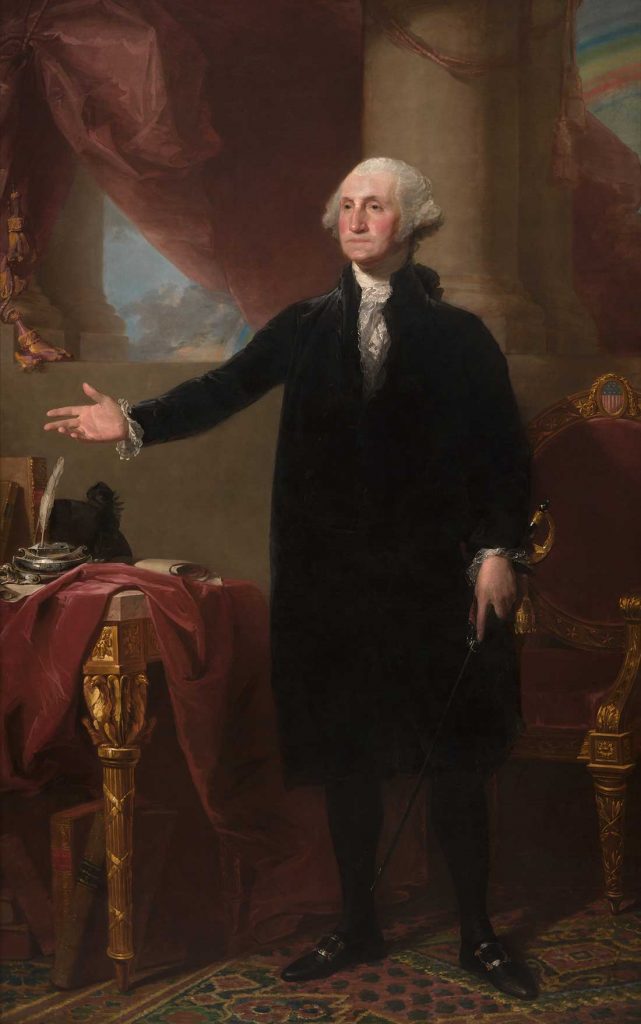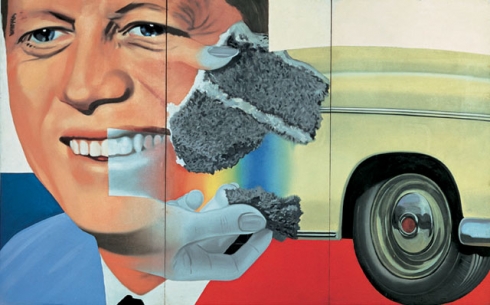As Presidents’ Day was earlier this week, we wanted to take a look at two famous paintings featuring two different presidents. There are so many presidential paintings to choose from, from the seemingly-stuffy less-visited ones in the National Portrait Gallery to the wildly-popular Obama portraits. We’ve chosen Gilbert Stuart’s Lansdowne Portrait (featuring George Washington) and James Rosenquist’s non-portrait-that-can-function-as-a-portrait President Elect (featuring John F. Kennedy). At the outset, these paintings might seem incredibly different. And yet, they portray two presidents, both alike in dignity–and the artistic styles that characterized their time in office.
George Washington (“Lansdowne Portrait“), Gilbert Stuart, 1796.

If there’s any painting you know of George Washington, it’s this one by Gilbert Stuart, also called the Lansdowne Portrait. Washington is captured in stately grace, with the intent that he look very much the political leader, not as much the famous general who led the American Revolution. Classical columns edge his study, in keeping with the Neoclassical style that characterized many portraits of the period. However, the portrait’s fame lies in the way Stuart captured Washington’s serious look, giving viewers the impression that this is very much a man whose country rests on his shoulders. Perhaps fittingly, the lore surrounding the painting is almost as famous as the art itself. Dolley Madison supposedly stopped to grab this portrait on her way out of the White House as the British stormed D.C. and ultimately burned the building during the War of 1812. It’s a larger-than-life story that goes hand-in-hand with the legacy of the painting, and that of Washington himself. And, of course, it’s the most famous painting Stuart ever did
President Elect, James Rosenquist, 1960-61, 1964.

Like Stuart’s painting, Rosenquist’s President Elect is probably his most famous work. Though it’s not necessarily a portrait in the sense that the Lansdowne is (though the image of JFK was copied from a campaign poster), the painting’s message is both worlds different and yet similar, as both paintings reflect the eras in which they were created. As Gilbert’s Washington had his columns, Rosenquist’s JFK has bright, Pop-Art-style colors and recognizable advertisement-style images. Just by incorporating elements of Pop art, President Elect automatically depicts Kennedy as hip and fresh–and, perhaps, a consumable commodity like the items he shares the canvas with, a piece of cake and a car. It’s no secret that JFK’s victories in televised debates had to do with his onscreen manner and looks when compared with Richard Nixon. Thus, his image would be perfect for Pop artists to use to make a statement. Perhaps conversely, the painting could argue that Kennedy was just as American as boxed cake and cars. President Elect is as layered in meaning as it is eye-catching–which makes its function triple, as it’s not just a piece of artwork that was good enough to be sold, but a sort of presidential portrait, and very much a portrait of the contemporary culture at the time JFK was elected.
So, what’s the takeaway of this post–besides the fact that both these presidential portraits reflect their respective eras and culture? It’s that paintings and portraits always have a story to tell. Even something as seemingly simple as a portrait can make a big argument–especially if its subject is a political leader.
Want to learn more about these portraits? Visit the National Portrait Gallery and this Prezi presentation.
What do we do here at the Art Docent Program? Find out more about us here!
Want more on cool portraits? Check out the rest of our blog!







